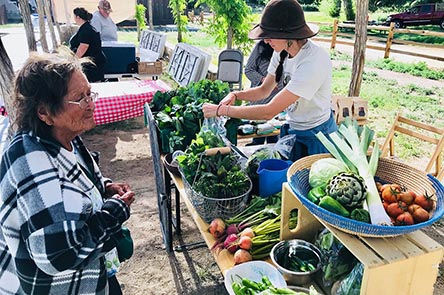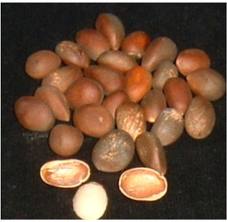
The Enduring Harvest: A Journey into the Paiute Tribe’s Traditional Foodways
By [Your Name/Journalist’s Name]
The Great Basin, a vast expanse of arid lands stretching across Nevada, Utah, California, and Arizona, might appear desolate to the untrained eye. Yet, for millennia, it has been home to the Paiute people, a resilient and resourceful tribe whose very existence was intricately woven into the land’s subtle rhythms and generous, if demanding, offerings. Their traditional food gathering practices were not merely about sustenance; they were a sophisticated system of ecological knowledge, spiritual connection, and communal survival, a legacy that continues to resonate powerfully today.

"Our ancestors left us a map written in the landscape," says Sarah Winnemucca Hopkins, a prominent Northern Paiute author and activist from the 19th century, whose words echo the profound wisdom passed down through generations. This "map" guided the Paiute through seasonal rounds, a nomadic existence dictated by the ripening of plants and the migrations of game. They were master ethnobotanists, understanding the lifecycle of hundreds of native plants, their nutritional value, medicinal properties, and the precise moment for their harvest.
The Sacred Piñon: A Staff of Life
At the heart of the Paiute diet, and indeed their cultural identity, stood the piñon pine (Pinus monophylla). The small, protein-rich nuts harvested from its cones were more than just food; they were a cultural cornerstone. The piñon harvest was a communal event, often spanning weeks in the late summer and early autumn. Families would travel to traditional gathering grounds in the mountains, setting up temporary camps.
"The piñon tree, she is our mother," says an elder, her voice raspy with age, sharing wisdom passed down from her grandmother. "She feeds us, she holds our stories. You must treat her with respect, leave enough for the squirrels, for the deer, and for the next generation." This philosophy of reciprocity and sustainability was central. Harvesters would carefully knock cones from branches with long poles, gathering them in woven baskets. The cones were then roasted over a slow fire to open them, releasing the prized nuts. The process was laborious but yielded a highly nutritious and storable food source that could sustain families through the harsh winter months. Piñon nuts could be eaten raw, ground into flour for bread or gruel, or mixed with berries and dried meat.
The importance of the piñon is underscored by its sheer caloric and nutritional value. Rich in protein, healthy fats, and essential minerals, a good piñon harvest meant survival. Its significance extended beyond the physical; piñon camps fostered social bonds, storytelling, and the transmission of knowledge from elders to youth.
A Diverse Pantry: Beyond the Piñon
While the piñon was paramount, the Paiute diet was remarkably diverse, reflecting their intimate knowledge of the varied ecosystems within their ancestral lands.
Seeds and Grains: The arid environment was surprisingly abundant with various seed-bearing plants. Indian ricegrass (Achnatherum hymenoides) was a staple, its tiny grains gathered and ground into flour. Chia seeds, known today as a superfood, were also collected and used for their energy-boosting properties. Other important seeds included those from sunflowers, various grasses, and wild rye. The gathering process often involved seed beaters – woven paddles used to knock seeds into large conical burden baskets. Once collected, seeds were parched (roasted) to prevent spoilage and then ground using manos and metates (hand stones and grinding slabs) into a fine flour, a process often performed by women.

Roots and Tubers: Beneath the seemingly barren soil lay a hidden bounty of roots and tubers. Camas (Camassia quamash), a lily-like plant with an onion-shaped bulb, was a significant food source in damper areas. The bulbs were slow-baked in earthen ovens for days, a process that converted their starches into digestible sugars, making them sweet and nutritious. Sego lily (Calochortus nuttallii), the state flower of Utah and a sacred plant, also provided an edible bulb. These underground treasures required extensive knowledge to locate and meticulous preparation to render edible and palatable.
Berries and Fruits: Juniper berries, though bitter, were a crucial source of vitamin C and could be dried and stored. Chokecherries, serviceberries, and buffaloberries provided seasonal sweetness and could be dried into cakes or mixed with dried meat to make pemmican, a highly concentrated energy food. Agave (Agave utahensis), particularly important for the Southern Paiute, provided a fibrous heart that, when slow-roasted in pits for days, became sweet and tender. Mesquite beans, rich in protein and carbohydrates, were also ground into flour or used to make a sweet beverage.
Game and Fish: The Paiute were also skilled hunters and fishers. Communal rabbit drives, where large groups would herd rabbits into nets, provided a significant source of protein and hides for clothing and blankets. Deer, antelope, and bighorn sheep were hunted using bows and arrows, traps, and snares. For those Paiute groups living near water bodies like Pyramid Lake, the Lahontan cutthroat trout was a critical food source. These impressive fish, some weighing over 40 pounds, were caught using nets, weirs, and spears. The importance of these fish stocks is highlighted by the devastating impact of damming and water diversion on their populations in later centuries, a stark reminder of how interconnected the Paiute were with their environment.
The Ethos of Sustainability and Reciprocity
What truly defined Paiute food gathering was not just the variety of foods, but the underlying philosophy. It was a practice rooted in deep respect for the land and its resources. They understood the delicate balance of their ecosystem and adhered to principles of sustainable harvesting long before the term became mainstream.
"You never take more than you need," an elder might instruct a child. "And you always leave some for the land to heal, for the animals to eat, and for the next year’s harvest." This ethos prevented over-harvesting and ensured the long-term viability of their food sources. They practiced selective harvesting, leaving some plants untouched to reseed. They knew when to burn certain areas to promote new growth and enhance yields. This was not mere resource management; it was a spiritual covenant with the Earth. Every plant, every animal, was seen as a relative, a gift from the Creator, deserving of gratitude and respectful utilization.
Disruption and Resilience: The Impact of Colonization
The arrival of Euro-American settlers in the 19th century brought catastrophic changes to the Paiute way of life. Land dispossession, forced relocation onto reservations, the destruction of traditional hunting grounds, and the depletion of vital water resources systematically dismantled their millennia-old food systems. The introduction of foreign diseases, new agricultural practices (often unsuitable for the Great Basin), and a Western diet heavy in processed foods led to widespread hunger, disease, and a profound cultural disruption.
"They took our land, they took our water, and then they told us to eat their flour and sugar," recounts a Paiute descendant, reflecting on the historical trauma. This forced transition contributed to the health disparities seen today in many Native American communities, including high rates of diabetes and heart disease, directly linked to the abandonment of traditional, nutrient-dense diets.
Revitalization: Reclaiming the Roots
Despite the immense challenges, the Paiute people have demonstrated remarkable resilience. Today, there is a powerful movement to revitalize traditional foodways, driven by a desire to reclaim health, cultural identity, and spiritual connection to the land.
Tribal communities are initiating programs to teach younger generations about traditional plant identification, gathering techniques, and food preparation. Elders, who hold invaluable knowledge, are central to these efforts, guiding youth on foraging expeditions, sharing stories, and demonstrating ancient skills like basket weaving for gathering or the use of grinding stones.
"It’s more than just learning to pick a berry," explains a cultural preservationist working with a Paiute youth group. "It’s about understanding the entire ecosystem, the seasons, the language associated with the plants, the songs, the ceremonies. It’s about rebuilding our relationship with the land and with ourselves."
Some Paiute communities are establishing tribal gardens focused on native plants, cultivating species like Indian ricegrass, sunflowers, and various traditional herbs. There’s also advocacy for water rights and the protection of ancestral lands, recognizing that access to healthy ecosystems is fundamental to the revival of traditional foods. Efforts are underway to restore fish populations in places like Pyramid Lake, a testament to the enduring connection between the Paiute people and their aquatic relatives.
The journey to reclaim traditional foodways is ongoing and multifaceted. It involves confronting historical trauma, navigating contemporary challenges like climate change and modern land use, and fostering a renewed sense of pride and self-sufficiency. It is a testament to the strength and adaptability of the Paiute people, who understand that true sustenance goes far beyond mere calories – it nourishes the body, mind, and spirit.
The Paiute’s enduring harvest is not just a historical footnote; it is a living, breathing testament to the profound wisdom embedded in indigenous cultures. Their traditional foods are a pathway to health, a repository of knowledge, and a powerful symbol of their unbreakable bond with the Great Basin, a bond that continues to feed their people, physically and spiritually, through the generations. The land, as always, continues to provide, for those who listen.


